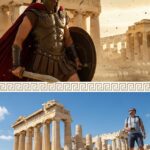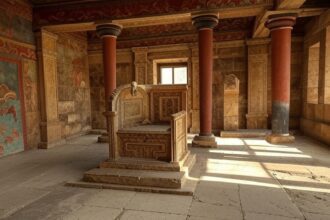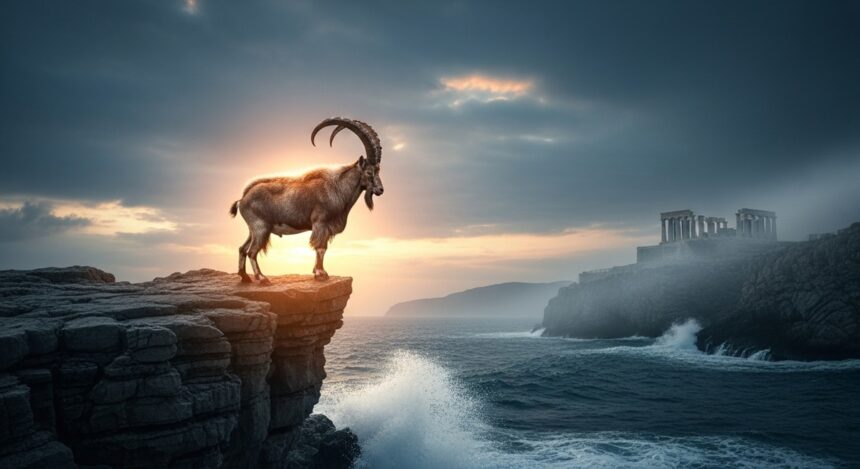The myth of the abduction of Europa is one of the most captivating stories in Greek mythology, weaving together themes of divine intervention, transformation, and the founding of a legendary lineage. This tale, rich with cultural and historical significance, tells the story of Europa, a Phoenician princess, and her extraordinary encounter with Zeus, the king of the gods, who transformed into a majestic bull to win her affection. Their journey to Crete and the legacy of their union have left an indelible mark on mythology, art, and even the naming of a continent.
The Origins of Europa: A Phoenician Princess
The story begins with Europa, a figure of grace and nobility in Greek mythology. She was the daughter of Agenor and Telephassa, rulers of the ancient Phoenician city of Tyre. As the sister of Cadmus, the legendary founder of Thebes, Europa was born into a lineage of great importance. Her beauty was renowned, and it was this allure that caught the attention of Zeus, the all-powerful god of the skies and ruler of Mount Olympus.

Europa’s story is not just about her divine encounter but also about her role as a bridge between cultures. As a Phoenician princess, she represents the connection between the ancient Near East and the Greek world, a theme that resonates throughout the myth. Her journey from Tyre to Crete symbolizes the blending of Eastern and Western traditions, a narrative that has fascinated scholars and storytellers for centuries.
The Setting: A Serene Meadow by the Sea

The myth unfolds in a picturesque meadow near the shores of Tyre, where Europa and her companions gathered to pick flowers and enjoy the beauty of the day. This tranquil setting, filled with vibrant blooms and the gentle sound of waves, sets the stage for the divine intervention that would change Europa’s life forever. The meadow, a place of innocence and leisure, contrasts sharply with the dramatic events that follow, highlighting the unpredictable nature of divine encounters in Greek mythology.
Zeus’s Transformation: The Majestic Bull
Enamored by Europa’s beauty, Zeus devised a plan to approach her without revealing his divine identity. Struck by Eros, the god of love, Zeus transformed himself into a magnificent bull. This was no ordinary beast—his form was calm, muscular, and strikingly beautiful, with a coat that gleamed under the sun. Grazing peacefully near Europa, Zeus as the bull exuded an aura of gentle strength, designed to captivate rather than frighten.

This transformation is a hallmark of Greek mythology, where gods frequently take on animal or human forms to interact with mortals. The choice of a bull is particularly significant, symbolizing power, fertility, and divine authority. In ancient cultures, bulls were revered as sacred animals, often associated with creation and kingship, making Zeus’s choice both strategic and symbolic.
Europa’s Enchantment and the Abduction
Drawn to the bull’s striking appearance, Europa approached him without fear. She caressed his flanks, marveling at his strength and beauty. In a moment of playful trust, she climbed onto his back, unaware of the divine force she was engaging with. Seizing the opportunity, Zeus sprang into action, bolting toward the sea at lightning speed. Europa, caught off guard, clung to the bull as he carried her across the waves, her cries echoing over the water.

The journey across the sea, accompanied by Tritons and Nereids—mythical sea deities—adds a fantastical element to the tale. These divine escorts underscore the significance of Europa’s abduction, framing it as a cosmic event orchestrated by the gods. The image of a Phoenician princess riding a bull through the sea has inspired countless works of art, from ancient Greek vases to Renaissance paintings, cementing its place in cultural history.
Arrival in Crete: The Birth of a Legacy
Upon reaching Crete, the bull vanished, and Zeus revealed his true form. He led Europa by the hand to the Dikteon Cave, a sacred site associated with his own birth and upbringing in some versions of the myth. Here, their love union took place, marking the beginning of a new chapter in Europa’s life. The Dikteon Cave, nestled in the mountains of Crete, is a place of profound mythological significance, often depicted as a sanctuary of divine encounters.

The union of Zeus and Europa produced three sons: Minos, Rhadamanthys, and Sarpedon. These figures would go on to become central to Cretan mythology and history. Minos, in particular, emerged as a legendary figure, known as the first Greek sea-ruler and a just legislator. His name is forever linked to the Minoan civilization, one of the earliest advanced societies in Europe, named in his honor.
Variations in the Myth: A Tapestry of Traditions
The myth of the abduction of Europa is not a singular narrative but a collection of variations, each adding depth and nuance to the story. Different ancient sources offer unique perspectives, reflecting the diverse ways in which the tale was told and interpreted.
The Dikteon Cave vs. the Evergreen Plane Tree
According to the ancient writer Lucian, the love union between Zeus and Europa took place in the Dikteon Cave, a location steeped in divine significance. Lucian’s account emphasizes the mystical and sacred nature of the encounter, tying it to the birthplace of Zeus himself. The imagery of Europa and Zeus in the cave, blushing and gazing at one another, adds a layer of intimacy to the myth.

In contrast, the tradition of the Gortynians places the union in Gortys, under the shade of an evergreen plane tree. This tree, which never sheds its leaves, became a symbol of eternal love and divine favor. The Gortynians immortalized this version of the story on their coins, depicting the plane tree as a testament to the myth’s enduring presence in their culture.

The Sons of Europa: Discrepancies in Lineage
The identity and number of Europa’s children vary across sources. Homer, in the Iliad, names only Minos and Rhadamanthys as the sons of Zeus and Europa, portraying them as judges in the underworld (Hades). This version emphasizes their divine heritage and their roles as figures of justice and authority.
However, Herodotus, the historian, presents a different perspective. He suggests that Minos was the son of Europa and a mortal Cretan, possibly Asterion, rather than Zeus. In this account, Sarpedon is Europa’s brother, not her son, and he competes with Minos for the throne of Crete. Defeated, Sarpedon flees to Miletus in Asia Minor, adding a layer of political intrigue to the myth.

Yet another version, also from Homer, attributes Sarpedon’s parentage to Zeus and Laodamia, daughter of Bellerophon, rather than Europa. This discrepancy highlights the fluidity of Greek mythology, where stories were adapted to suit different cultural and regional contexts.
Europa’s Life After Zeus: A New Beginning
After Zeus returned to Mount Olympus, Europa did not fade into obscurity. She married Asterion, the king of Crete, who adopted her sons—Minos, Rhadamanthys, and Sarpedon—as his own. This union solidified Europa’s place in Cretan society, transforming her from a Phoenician princess into a queen of a new land. Upon Asterion’s death, Minos ascended to the throne, becoming a legendary ruler whose legacy shaped the history of Crete.

The adoption of Europa’s sons by Asterion reflects themes of continuity and integration. It also underscores Europa’s role as a foundational figure in the mythology of Crete, linking her to the origins of the Minoan civilization.
The Cultural Impact of the Myth
The myth of the abduction of Europa inspired the naming of the continent of Europe, symbolizing the cultural and geographical bridge between East and West. In art, the image of Europa riding the bull has been a recurring motif, from ancient Greek pottery to modern sculptures. The myth also influenced literature, with poets and writers reinterpreting the story to explore themes of love, power, and destiny.
In Crete, the myth is deeply embedded in local culture. Sites like the Dikteon Cave and the plane tree of Gortys remain popular destinations for tourists and scholars alike, serving as tangible links to the ancient story. The Minoan civilization, with its advanced art, architecture, and maritime prowess, is often seen as a reflection of the legacy of Minos and, by extension, Europa.
Why the Myth Endures
The myth of the abduction of Europa resonates because it encapsulates universal themes: the interplay between mortal and divine, the transformative power of love, and the journey from one world to another. Europa’s story is one of agency and adaptation—she transitions from a princess to a queen, from a figure of myth to a symbol of cultural heritage. The variations in the myth reflect the richness of Greek storytelling, where different regions and authors could reinterpret the same tale to suit their own perspectives.
For modern audiences, the myth offers insights into ancient beliefs about divinity, gender, and power. It also serves as a reminder of the interconnectedness of ancient cultures, with Europa’s journey from Phoenicia to Crete symbolizing the exchange of ideas and traditions across the Mediterranean.
Exploring Crete: A Journey into Myth
For those inspired to explore the myth of the abduction of Europa, Crete offers a wealth of historical and mythological sites. The Dikteon Cave, located in the Lassithi Plateau, is a must-visit for its connection to Zeus and Europa. The archaeological site of Knossos, associated with Minos and the Minoan civilization, provides a glimpse into the world that Europa’s legacy helped shape. The city of Gortys, with its ancient plane tree, offers another tangible link to the myth, inviting visitors to imagine the divine encounter that took place in its shade.






















